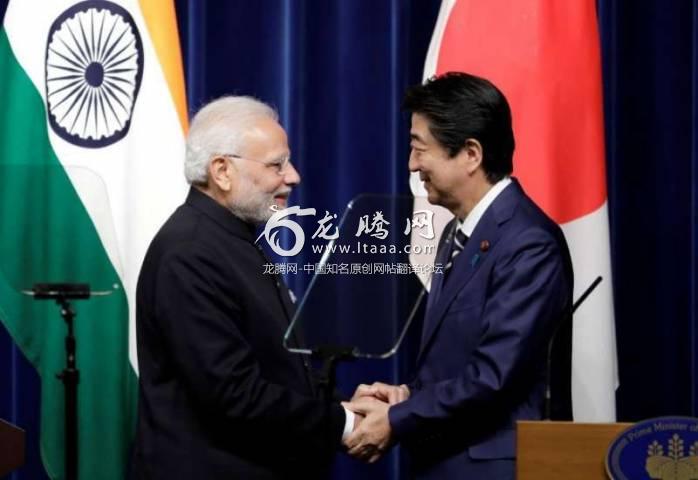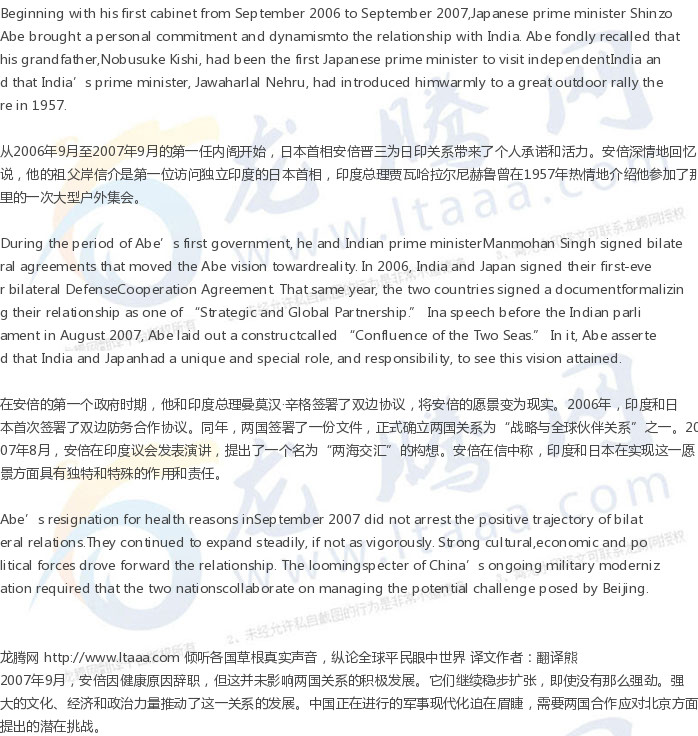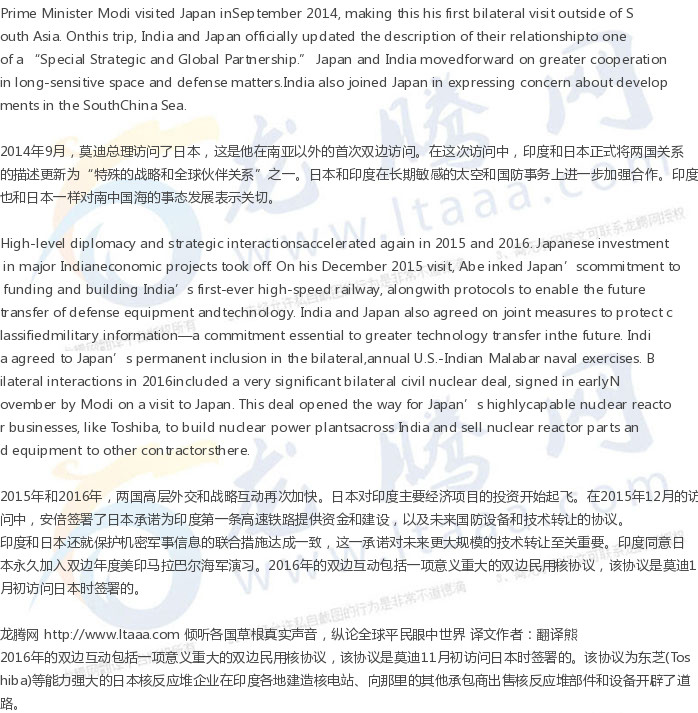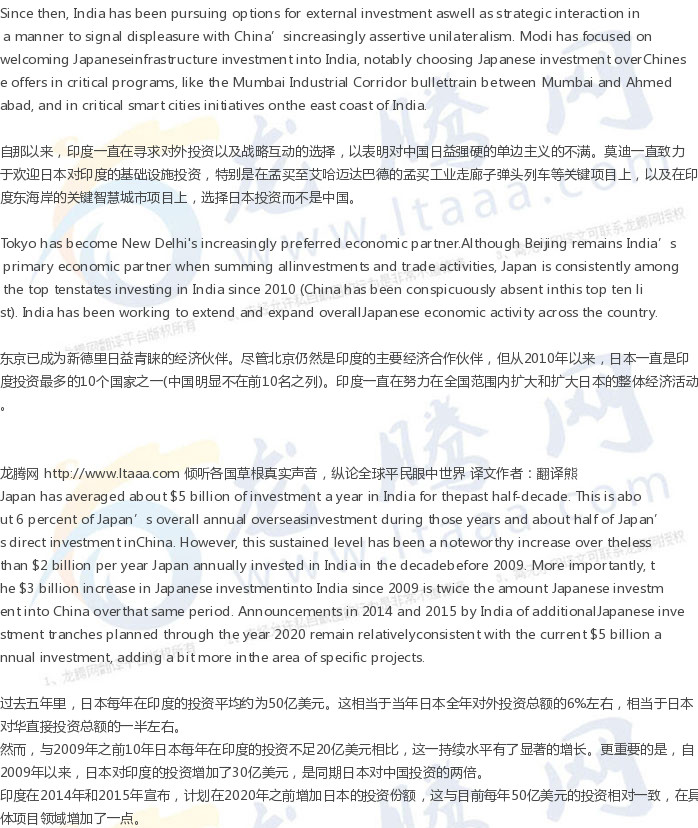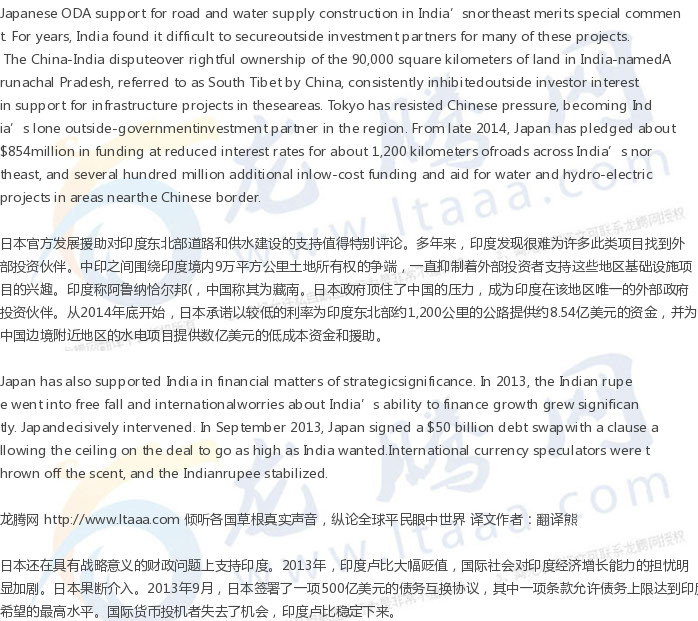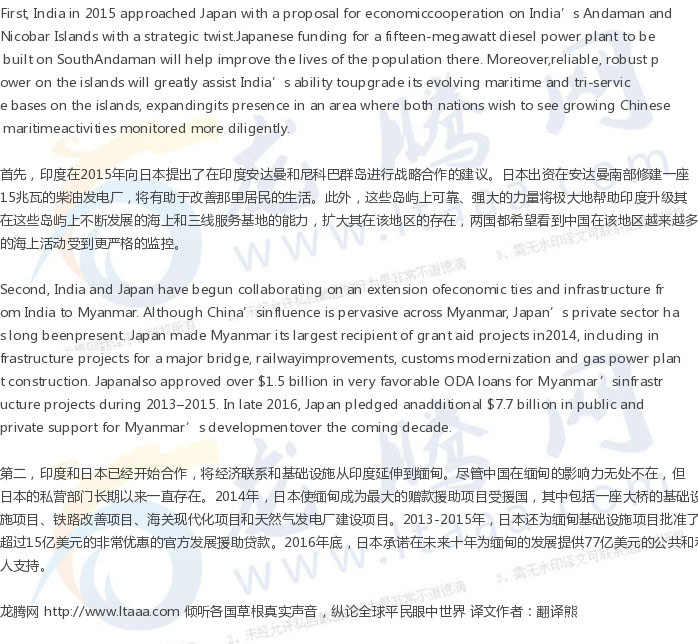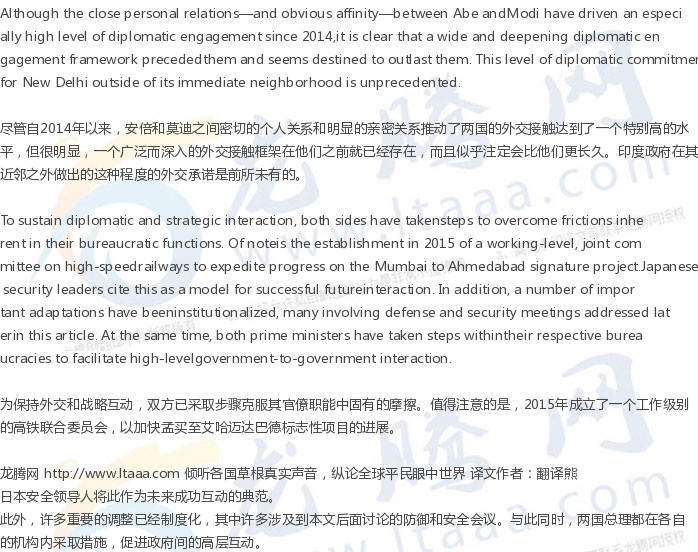不断增长的印日关系(上) [美国媒体]
印日战略与防务关系显示出最大的区域潜力,有助于增强支持美国长期和持久的经济、人道主义和安全目标的能力。
前言:
印日战略与防务关系显示出最大的区域潜力,有助于增强支持美国长期和持久的经济、人道主义和安全目标的能力。
India and Japan share complementary, butnot identical, strategic visions. New Delhi and Tokyo both seek to manage—andminimize—the potential negative impacts from the rise of China in accord withtheir own strategic perspectives. Japan perceives China’s increasinglyassertive actions to be a great and growing strategic threat. India, for itspart, is concerned about China’s increasingly worrisome behavior, but findsitself relatively more dependent upon China for economic growth and lessworried about China’s immediate physical threat than Japan. As a result, Indiahas been—and will continue to be—less vocal in complaints about Chinesebehavior, preferring to warn Beijing with subtle signaling and actions.
印度和日本的战略愿景是互补的,但并不完全相同。新德里和东京都试图按照各自的战略观点,管理并尽量减少中国崛起的潜在负面影响。日本认为,中国日益强硬的行动是一个日益严重的巨大战略威胁。就印度而言,它对中国日益令人担忧的行为感到担忧,但它发现自己在经济增长方面相对更依赖中国,而不像日本那样担心中国的直接实体威胁。因此,印度已经——并将继续——对中国的行为避免抱怨,相反更愿意用微妙的信号和行动来警告北京。
The India-Japan strategic partnership hasyet to garner much attention in Washington during the Trump administration, butit should. Inevitably, any U.S. administration that wishes sustained influencein the Indo-Pacific must do so with an eye toward help from traditional andemerging security partners. Japan is a traditional security partner and Indiaan emerging one. Americans should become more familiar with the backstory andcontemporary economic, political and security manifestations of this rapidlyevolving and very significant strategic partnership.
在特朗普执政期间,印日战略伙伴关系尚未在华盛顿获得太多关注,但它应该得到关注。不可避免的是,任何希望在印太地区保持影响力的美国政府都必须着眼于传统和新兴安全伙伴的帮助。日本是传统的安全伙伴,印度是新兴的安全伙伴。美国人应该更加熟悉这种迅速发展和非常重要的战略伙伴关系的背景和当代经济、政治和安全表现。
The second phase of the relationship beganin the first year of the new millennium and continued through the end of 2005.It commenced with the historic visit of American president Bill Clinton toIndia in March 2000—the first by a U.S. president for more than twenty years.Taking a cue from the Clinton visit, Japanese prime minister Yoshiro Moritraveled to New Delhi in August 2000, where he announced the Japan-India GlobalPartnership. Since then, prime ministers of both the Liberal Democratic Partyand the Democratic Party of Japan have visited India. Beginning with the visitof Prime Minister Junichiro Koizumi to India in 2005, Japanese and Indian primeministers have held annual, alternate-host summits. On the security front, theIndian and Japanese Coast Guards began annual joint exercises and leadershipexchange visits in 2000.
两国关系的第二阶段始于新千年的第一年,一直持续到2005年底。它始于2000年3月美国总统比尔·克林顿对印度的历史性访问,这是20多年来美国总统首次访问印度。受克林顿访问的启发,日本首相森义郎于2000年8月访问新德里,宣布了日印全球伙伴关系。此后,自民党和日本民主党的首相都访问了印度。从2005年小泉纯一郎首相访问印度开始,日本和印度总理每年都会轮流举行峰会。在安全方面,印度和日本海岸警卫队于2000年开始年度联合演习和领导人互访。
By late 2006, a third and much broader phase of strategic engagement beganbetween India and Japan. The phase evolved in parallel with greater defense andsecurity engagement by the U.S. presidential administration of George W. Bushwith India under the aegis of its “dehypenation policy.” Japan-India relationsbecame increasingly geostrategic in nature.
到2006年底,印度和日本开始了第三个、范围更广的战略接触阶段。与此同时,美国总统布什加强了与印度的防务和安全接触。日印关系的地缘战略性质日益明显。
Abe’s return as Japanese prime minister inDecember 2012 set the stage for even greater acceleration in the third phase ofthe Indo-Japanese bilateral relationship. India signaled its deep commitment toJapan as a strategic partner by making Abe the first ever Japanese dignitary tobe the chief guest at India’s Republic Day in January 2014—India’s highestdiplomatic honor. That spring, Indian elections brought Narendra Modi of thenationalist Bharatiya Janata Party to power, and the bilateral relationshiptook a dramatic spring forward.
2012年12月,安倍再次担任日本首相,为进一步加快印日双边关系第三阶段的发展奠定了基础。2014年1月印度共和国日是印度的最高外交荣誉。印度通过让安倍成为首位作为首席嘉宾出席印度共和国日的日本政要,表达了对日本作为战略伙伴的坚定承诺。印度通过让安倍成为首位以贵宾身份在2014年2月印度国庆日——印度最高的外交荣誉访问印度的日本政要,表达了对日本作为战略伙伴的坚定承诺。那年春天,印度大选让民族主义政党印度人民党的纳伦德拉莫迪上台,两国关系出现了戏剧性的飞跃。
India’s metamorphosis as a modernAsian-engaged nation began in the early 1990s. In 1991, India confrontedsimultaneous, related crises that demanded a re-think of its decades-oldNonalignment strategy. The first crisis was economic, in the form of a severebalance of payments crisis. The second crisis was geostrategic. India’sprincipal security and economic partner from 1971–1990, the Soviet Union,collapsed. India lost Soviet subsidies, customers and suppliers in Russia andacross the fragmenting Soviet bloc. It also lost its ability to stay distantfrom the global first world economy led by the United States and Westernpowers.
印度作为一个现代亚洲国家的转型始于上世纪90年代初。1991年,印度面临着同时发生的相关危机,需要重新考虑其几十年的不结盟战略。第一次危机是经济危机,表现为严重的国际收支危机。第二个危机是地缘政治危机。1971年至1990年间,印度的主要安全和经济伙伴苏联解体。印度失去了苏联的补贴,失去了俄罗斯以及整个分裂的苏联集团的客户和供应商。它也失去了与美国和西方大国领导的全球第一世界经济体保持距离的能力。
In 2000, then-Indian prime minister Vajpayee expanded economic andcultural relations with Japan into dialogue and exchange about geostrategicmatters of mutual interest. Mori’s August visit to India reciprocated andextended the relationship dramatically. By the mid-2000s, Indian policymakerspositioned the Japan-India relationship at the very top of a growing array ofstrategically important bilateral relationships evolving across theIndo-Asia-Pacific region.
2000年,时任印度总理的瓦杰帕伊扩大了与日本的经济和文化关系,就共同关心的地缘战略问题开展对话与交流。Mori8月对印度的访问是对两国关系的回报,并极大地扩展了两国关系。到2000年代中期,印度决策者将日印关系置于印-亚太地区不断发展的一系列具有重要战略意义的双边关系的首位。
In November 2014, some six months after his ascension as prime minister,Narendra Modi announced that India would pursue an Act East policy, extendingbeyond the two-decade-old Look East policy. His announcement—which utilized aphrase first uttered in a policy speech by U.S. Secretary of State HillaryClinton on her 2011 visit to India—aimed to further invigorate Look East with awider set of engagements across the Asia-Pacific region. The Modi governmentcalled for greater external investment in India to build state infrastructure,smart cities and economic competitiveness (especially in manufacturing).
2014年11月,也就是纳伦德拉莫迪成为印度总理大约6个月后,他宣布印度将推行“向东行动”(Act East)政策,超越已有20年历史的“向东看”(Look East)政策。
他的声明是美国国务卿希拉里·克林顿2011年访问印度时首次在政策演讲中提出的,目的是通过在亚太地区开展更广泛的接触,进一步振兴“向东看”。莫迪政府呼吁加大对印度的外部投资,以建设国家基础设施、智慧城市和经济竞争力(尤其是制造业)。
Japan’s government-to-government official development assistance (ODA) isa critical component of its overall economic support for India. Japan initiatedits ODA program for India in 1958. In 2003–04, India became the largest singlerecipient of Japanese ODA. This program has focused on the development ofindustry-related infrastructure and India’s energy infrastructure (increasingrenewable energy capacity and rural electrification). It is noteworthy thatJapan exempted India from cuts in its ODA budget in the wake of the tsunami andmeltdown of the nuclear reactors in Fukushima in March 2011.
日本政府间官方发展援助(ODA)是其对印度全面经济支持的一个关键组成部分。日本于1958年启动了对印度的官方发展援助项目。2003年至2004年,印度成为日本官方发展援助的最大单一接收国。该项目重点发展与工业相关的基础设施和印度的能源基础设施(增加可再生能源能力和农村电气化)。值得注意的是,2011年3月福岛核反应堆发生海啸和熔毁后,日本免除了印度的官方发展援助预算削减。
In December 2015, Abe and Modi signed documents in New Delhi markinganother expansion in the scope of Japanese investment into India. Theseincluded an announcement that Japan would fund a $15 billion project to build ahigh speed “bullet train” between Mumbai and Ahmedabad in India’s northeast,outbidding a Chinese proposal for this same project.
2015年12月,安倍和莫迪在新德里签署文件,标志着日本在印度的投资范围再次扩大。其中包括一项协议,日本将出资150亿美元在印度东北部孟买和艾哈迈达巴德之间修建一条高速“子弹头列车”(bullet train),其投标价格将超过中国对这一项目的提议。
The two strategic partners formalized the hallmark India-Japan CivilNuclear Agreement during Modi’s November 2016 annual summit meeting in Japanand put it into force in July 2017. Their November 2016 summit statementextended the India-Japan Vision 2025 document signed in New Delhi during theprevious annual summit of December 2015, and confirmed the strategic nature ofJapan’s economic assistance to India itself and to mutual interests in thewider region that help counter the potential for undesirable Chinese influence.Three Japanese ventures in the Indian Ocean basin stand out.
在莫迪2016年11月于日本举行的年度峰会上,两国战略伙伴正式签署了标志性的印日民用核协议,并于2017年7月生效。2016年11月峰会声明在新德里签署, 确认了日本对印度自身的经济援助的战略性质,以及对更广泛地区的共同利益的援助,这有助于对抗中国可能产生的不良影响。日本在印度洋盆地的三家合资企业表现突出。
For its part, India views Myanmar as its gateway to the East. Modiannounced the Act East policy there on a visit to Naypyidaw in late 2014.Although India-Myanmar trade has been paltry, India has begun more deliberatetrade and transit interaction with Myanmar. New Delhi continues to supportJapan’s robust investments in Myanmar, looking to link those with complementaryones in northeast India and with other traditional Indian economic partners.
就印度而言,它把缅甸视为通往东方的门户。莫迪在2014年底访问内比都时宣布了东部政策。尽管印缅贸易微不足道,但印度已开始与缅甸进行更有意的贸易和过境往来。印度政府继续支持日本在缅甸的强劲投资,希望将这些投资与印度东北部的互补投资以及印度其他传统经济伙伴联系起来。
Finally, Japan has joined India in a joint project to develop the strategically important port of Charbahar in Iran. India launched a collaborative venture with Iran and Afghanistan in mid-2016 to boost economic ties and access to natural resources and trade routes stretching from Charbahar to Central Asia. The Charbahar project includes construction and operation of port facilities there, the creation of special economic zones nearby and the development of road and rail connections through Iran, Afghanistan and into Central Asia. This infrastructure will be a parallel route and a potential competitor to the Chinese-sponsored Belt and Road Initiative and its key north-south land component through South Asia: the China-Pakistan Economic Corridor.
最后,日本加入印度的一个联合项目,开发具有重要战略意义的伊朗沙巴尔港。2016年年中,印度与伊朗和阿富汗启动了一项合作项目,旨在加强经济联系,扩大自然资源和从恰巴尔到中亚的贸易通道。沙巴尔项目包括在那里建设和运营港口设施,在附近建立经济特区,以及通过伊朗、阿富汗和中亚发展公路和铁路连接。这一基础设施将是一条平行的路线,并可能与中国发起的“一带一路”及其贯穿南亚的重要南北陆地组成部分——中巴经济走廊——形成竞争。
Unique diplomatic and bureaucratic arrangements now characterize thebilateral relationship between India and Japan. Expanding in scope and depth,these now feature some unique administrative arrangements and activities aimedat working around the most notorious features of India’s often scleroticbureaucracy and in a manner aimed to assure that a robust bilateralrelationship will outlast any one Japanese or Indian prime minister.
独特的外交和官僚安排现在成为印度和日本双边关系的特点。在范围和深度不断扩大的情况下,这些协议现在有了一些独特的行政安排和活动,旨在解决印度僵化的官僚体制中最臭名昭着的特点,并以一种旨在确保稳固的双边关系比任何一位日本或印度总理都持久的方式进行。
Abe has made the bilateral partnership with India a national security anddiplomatic priority. Since 2014, the Japanese National Security Secretariat hasmet frequently to discuss the Japan-India relationship, with Japan’s ambassadorto India regularly attending when in country.
安倍把与印度的双边伙伴关系作为国家安全和外交的优先事项。2014年以来,日本国家安全秘书处频繁举行会议,讨论日印关系,日本驻印度大使在印度期间定期出席。
In India, Modi has enabled Japan unprecedented access within theall-important Indian Ministry of External Affairs (MEA). In 2015, India grantedJapan a special ombudsman position directly within the MEA. This representativehas special access to the MEA leadership and, as necessary, directly to Modihimself in order to assure that Japanese projects and activities get toppriority across the Indian bureaucracy. Combined, these top-level specialarrangements aim to institutionalize a special political and bureaucraticrelationship before the upcoming 2019 Indian general election.
在印度,莫迪让日本史无前例地进入至关重要的印度外交部。2015年,印度在多边环境协定中直接给予日本一个特别申诉专员的职位。这名代表可以特别接触印度外交部领导层,并在必要时直接接触莫迪本人,以确保日本的项目和活动在印度官僚机构中得到优先考虑。这些高层特别安排的目的是在即将到来的2019年印度大选之前,将一种特殊的政治和官僚关系制度化。
版权声明
我们致力于传递世界各地老百姓最真实、最直接、最详尽的对中国的看法
【版权与免责声明】如发现内容存在版权问题,烦请提供相关信息发邮件,
我们将及时沟通与处理。本站内容除非来源注明五毛网,否则均为网友转载,涉及言论、版权与本站无关。
本文仅代表作者观点,不代表本站立场。
本文来自网络,如有侵权及时联系本网站。
图文文章RECOMMEND
热门文章HOT NEWS
-
1
Why do most people who have a positive view of China have been to ...
- 2
- 3
- 4
- 5
- 6
- 7
- 8
- 9
- 10
推荐文章HOT NEWS
-
1
Why do most people who have a positive view of China have been to ...
- 2
- 3
- 4
- 5
- 6
- 7
- 8
- 9
- 10
